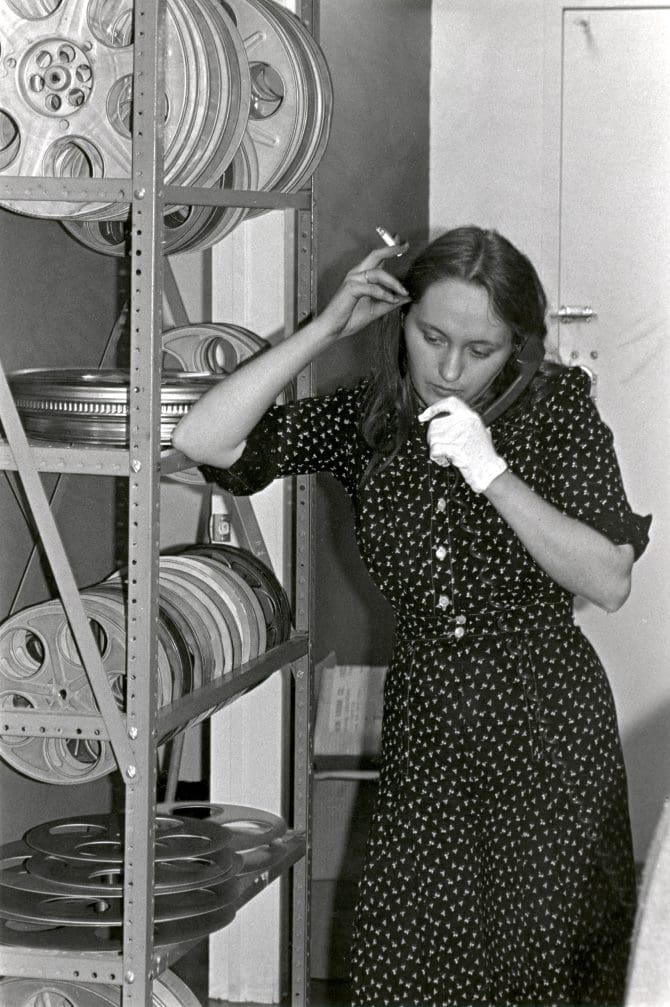By Alea Stokes, Research Services Librarian at the BPL
Women have worked in all areas of the film industry since motion pictures were invented in 1888. In fact, by 1923 women owned the majority of the independent film production companies in the United States. Despite early successes, scholars write that by the late 1920s women were actively being pushed out of every sector in Hollywood. Yet women hung onto editing jobs. Today women still make up about a third of film editors in the U.S.
Originally, movies were made by filming in “one shot” with the camera continuously rolling. When directors began filming multiple shots for a scene, they needed staff to cut out the best shots and rearrange them to tell the film’s story. Editing called for long hours of detailed handiwork. The job was considered unskilled labor, so uneducated women were hired for low wages. These women were called “cutters” because “they hand cranked film on reels, used scissors to manually cut footage, and then glued strips together.” When sound was introduced to moving pictures, men decided editing both sound and film would be too complex for women to handle. The job title went from “cutter” to “editor” as more men took over the role.
An editor can either improve a film with their work or make a film worse. Working in a dark room, largely by themselves, editors develop the plot of a story by controlling the flow of information audiences receive. Editing can change the pace, add tension or humor, and improve an actor’s performance. Thelma Schoonmaker, Martin Scorsese's long-time editor, said “[editing] is like sculpture. You get a big lump of clay, and you have to form it — this raw unedited, very long footage.” An editor’s goal is to create a seamless viewing experience for the audience.
Several female editors are trusted collaborators to the biggest directors in Hollywood history. Schoonmaker and Scorsese, mentioned above, are one example. Anne Bauchens, a prolific editor, worked with Cecil B. De Mille for forty years. Among her many Oscar nominated films, she edited, The Ten Commandments (1956). The epic required Bauchen to edit 100,000 feet of film. Sally Menke collaborated with Quentin Tarantino for seven of his films, from Reservoir Dogs (1992) to Inglourious Basterds (2009).
Unfortunately, few female editors have been awarded for their work monetarily or through industry recognition. Female editors are still paid less for their work than their white male counterparts. An Oscar for editing wasn’t won by a woman until Bauchens in 1940. In 1967 the first female editor was named in the opening credits of a film. Dede Allen received that honor for her work on Bonnie and Clyde, just one film from her sixty-year career.
There are even more barriers for women of color, although they have long been a part of the film industry. Two Black women, Tressie Sauders and Maria P. Williams, produced their own films in 1922 and 1923 in Kansas City, MO. A century later, Joi McMillon was the first black woman to be nominated and win an Oscar for her work on Moonlight (2017). McMillon has said in interviews that the high cost of union dues and her lack of connections in Los Angeles hampered her career as well as many other talented editors of color.
There are hundreds of others female editors who have helped make film history. Many are honored in Princeton University’s online archive, Edited By, which contains a growing index of female editors. Behind the scenes, female editors have advanced the art of editing to make cinematic history — and they will continue to do so.
BPL Resources
Films on Kanopy
- The Ten Commandments (1923)
- The Greatest Show on Earth (1952)
- Desperately Seeking Susan (1985)
- Moonlight (2017)
- Portrait of a Lady on Fire (2019)
- Filmmakers on Film – Pioneering Women in Film Collection (2009)
- Editors on Editing (2009)



Add a comment to: On the Cutting Room Floor: The Little-Known Careers of Female Film Editors